It is a cozy Sunday morning, the house is quiet, my husband is in Saudi Arabia, my daughter working at the kennel, the “bottom feeders” (an affectional term for the crew of guys that occasionally live in my basement) are home from national guard drills and sound asleep. It is raining. A gentle summer rain, making a tiny attempt at quenching the thirst of the bone dry dusty landscape that was once lush NJ greenery. A perfect day to write.
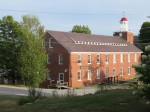
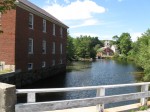
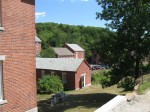
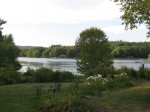 I returned late Friday night from an amazing week at Historic Harrisville, where I taught in the Weaving Center at Harrisville designs, which operates in the old mill town, built in the 1790’s. From what I understand, this is one of the only remaining intact mill villages left in New England, perfectly preserved. Harrisville Designs, as we know it today, started around 1970, not long before my own career as a handweaver began in 1974 with my first college class. Harrisville Shetland yarns and looms, especially the kit loom, have been part of my weaving language since the mid 70’s. Some of my early craft fair work used the Harrisville Shetland yarns, and though I never actually owned the kit floor loom, they were part of my repetoire for decades, most weaving studios where I taught had a number of these small compact, portable, inexpensive four shaft looms (I just found out it comes in an 8 shaft version as well), they did their job as the perfect introductory floor loom for an inexpensive price (still under $1000.), and the amazing thing, it is still being manufactured, if you find one on eBay, you can still get parts for it, the loom has endured, and I’m thrilled to know that this could be just the thing to launch all those Rigid Heddle Weavers coming into weaving from the knitting community, onto a real honest to goodness floor loom, where they can explore endless patterns and fabrics, 22″ wide is perfect for yardage for just about any type of garment!
I returned late Friday night from an amazing week at Historic Harrisville, where I taught in the Weaving Center at Harrisville designs, which operates in the old mill town, built in the 1790’s. From what I understand, this is one of the only remaining intact mill villages left in New England, perfectly preserved. Harrisville Designs, as we know it today, started around 1970, not long before my own career as a handweaver began in 1974 with my first college class. Harrisville Shetland yarns and looms, especially the kit loom, have been part of my weaving language since the mid 70’s. Some of my early craft fair work used the Harrisville Shetland yarns, and though I never actually owned the kit floor loom, they were part of my repetoire for decades, most weaving studios where I taught had a number of these small compact, portable, inexpensive four shaft looms (I just found out it comes in an 8 shaft version as well), they did their job as the perfect introductory floor loom for an inexpensive price (still under $1000.), and the amazing thing, it is still being manufactured, if you find one on eBay, you can still get parts for it, the loom has endured, and I’m thrilled to know that this could be just the thing to launch all those Rigid Heddle Weavers coming into weaving from the knitting community, onto a real honest to goodness floor loom, where they can explore endless patterns and fabrics, 22″ wide is perfect for yardage for just about any type of garment!
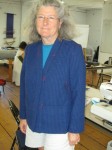
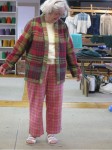
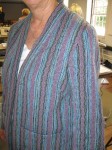
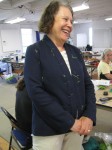 The class itself was a dream. The space was huge, well lit, plenty of room to move around, the students, all 10 of them had handwoven cloth. Many of them had taken weaving classes at Harrisville, and all of them produced very very competent cloth, the best group I’ve ever seen in any one class. All were sett appropriately, and finished well. This is a group of well trained weavers. It was a joy to watch them turn their fabrics into a garment that made them happy. Only one of the students had studied with me before, making the jacket in a different venue. For a repeating student like that, I always let them bring whatever they want to work on, and this particular student didn’t disappoint. Pat brought a pile of UFO’s, affectionately called Unfinished Objects, and we worked to bring them out of the box and into fruition. Sometimes you just get stuck and don’t know how to move forward… That’s the part I love best about this class.
The class itself was a dream. The space was huge, well lit, plenty of room to move around, the students, all 10 of them had handwoven cloth. Many of them had taken weaving classes at Harrisville, and all of them produced very very competent cloth, the best group I’ve ever seen in any one class. All were sett appropriately, and finished well. This is a group of well trained weavers. It was a joy to watch them turn their fabrics into a garment that made them happy. Only one of the students had studied with me before, making the jacket in a different venue. For a repeating student like that, I always let them bring whatever they want to work on, and this particular student didn’t disappoint. Pat brought a pile of UFO’s, affectionately called Unfinished Objects, and we worked to bring them out of the box and into fruition. Sometimes you just get stuck and don’t know how to move forward… That’s the part I love best about this class.
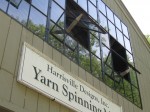
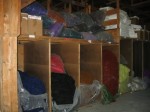 There were some wonderful side trips this week, to the Harrisville Spinning Mill (where they have interesting ideas about what to do with all those empty cones), where all the Harrisville yarns are spun, along with Peace Fleece and a new line from a yarn designer whose name went totally out of my head, silly me, but it had something to do with Brown Tweed. The yarns were gorgeous. Babs, who has been a fixture at the mill for 30 years, gave us the tour, starting in the storage area at the beginning, where New Zealand fleece comes in from the dyers. The colors were bright and fresh, and I wanted to go diving into the wool.
There were some wonderful side trips this week, to the Harrisville Spinning Mill (where they have interesting ideas about what to do with all those empty cones), where all the Harrisville yarns are spun, along with Peace Fleece and a new line from a yarn designer whose name went totally out of my head, silly me, but it had something to do with Brown Tweed. The yarns were gorgeous. Babs, who has been a fixture at the mill for 30 years, gave us the tour, starting in the storage area at the beginning, where New Zealand fleece comes in from the dyers. The colors were bright and fresh, and I wanted to go diving into the wool.
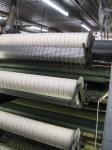 We watched the pickers, and the carding machines, and the machines that carefully created the fine roving that would eventually be spun. They were working on white today. The dust in the room was sort of amazing, hanging and clinging to every available surface, I so wanted to grab a vacuum…
We watched the pickers, and the carding machines, and the machines that carefully created the fine roving that would eventually be spun. They were working on white today. The dust in the room was sort of amazing, hanging and clinging to every available surface, I so wanted to grab a vacuum…
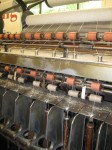
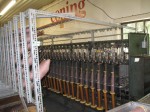
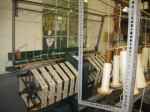
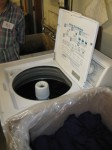
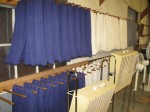 We watched the spinning machines, and the machine that plied the wool, until it finally wound onto skeins and then Babs showed us the most amazing thing, the yarns are then washed in the skein, gently, in a 25 year old top loader, where she carefully controls the soak, the spin and the amount of water coming back in during the rinse cycle, and then the skeins are hung to dry. Someone sits at a desk and hand wraps the wrapper around each skein.
We watched the spinning machines, and the machine that plied the wool, until it finally wound onto skeins and then Babs showed us the most amazing thing, the yarns are then washed in the skein, gently, in a 25 year old top loader, where she carefully controls the soak, the spin and the amount of water coming back in during the rinse cycle, and then the skeins are hung to dry. Someone sits at a desk and hand wraps the wrapper around each skein.
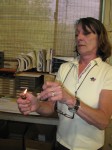
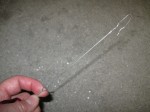 Babs also gave us a quick demonstration on how to turn a standard wide eyed heddle into a repair heddle, by heating the soldered ends with a lighter. Once hot, she banged the soldered end onto the concrete floor to snap the solder joint, and unwound the end of the metal heddle. For the non weavers out there, the heddles are the wires that hang from the shafts that control each individual warp thread. Sometimes you just make a mistake in threading and instead of tying in a string heddle, or actually cutting the heddle head with wire cutters like I do, this is a cool trick for adding a missing heddle onto a different shaft when one does make that dreaded threading error.
Babs also gave us a quick demonstration on how to turn a standard wide eyed heddle into a repair heddle, by heating the soldered ends with a lighter. Once hot, she banged the soldered end onto the concrete floor to snap the solder joint, and unwound the end of the metal heddle. For the non weavers out there, the heddles are the wires that hang from the shafts that control each individual warp thread. Sometimes you just make a mistake in threading and instead of tying in a string heddle, or actually cutting the heddle head with wire cutters like I do, this is a cool trick for adding a missing heddle onto a different shaft when one does make that dreaded threading error.
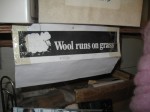
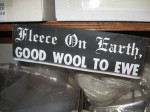 Of course, what would a spinning mill be without the requisite wool humor!
Of course, what would a spinning mill be without the requisite wool humor!
Chick Colony, founder of Harrisville Designs, spent some time with us Friday afternoon, giving us the history of the mill and his family’s involvement. It is a great story of the history of the textile industry in this country, and how things change sometimes wiping out entire industries almost overnight. It is a history we are seeing first hand today in almost every thing we know. It is a story of survival, of regrouping, of coming together as a community to save a village, and it is a story of seeing the handweaving community as we know it today, getting a fresh infusion of young knitters who are discovering what all of us who were trained back in the good old days, came to know and love, and spend a lifetime exploring, after 35 years at the weavng loom, I feel like I’ve only scratched the surface.
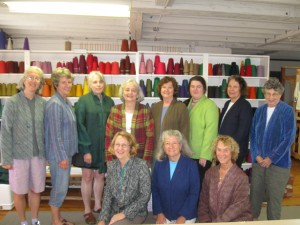 So Friday afternoon, the class got together for one group photo, all wearing their finished jackets, some still with tailor’s tacks, I don’t let them take them out until I’m safely back in NJ. 🙂 They learned a lot, and are looking forward to next year, Harrisville has already requested dates from me for 2011. I love teaching in this kind of venue, there is a great energy, and repeat students bring me fresh challenges, and I get to see their skills grow and develop as they launch into a world where they aren’t just weaving cloth, they are making garments for themselves. I’m looking forward to next weekend when I fly to Washington Island, Wisconsin to teach the same class “A Wearable Extravaganza” at Siever’s Fiber School.
So Friday afternoon, the class got together for one group photo, all wearing their finished jackets, some still with tailor’s tacks, I don’t let them take them out until I’m safely back in NJ. 🙂 They learned a lot, and are looking forward to next year, Harrisville has already requested dates from me for 2011. I love teaching in this kind of venue, there is a great energy, and repeat students bring me fresh challenges, and I get to see their skills grow and develop as they launch into a world where they aren’t just weaving cloth, they are making garments for themselves. I’m looking forward to next weekend when I fly to Washington Island, Wisconsin to teach the same class “A Wearable Extravaganza” at Siever’s Fiber School.
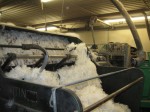
Harrisville was where I tool my first weaving class, with Deborah Chandler no less. It was amazing. I went back once more and just marvel at the space available for classes.
You will be heading up to Seivers and another place I have been many times, and love it too. My friend, Terry, will be there again this year with you.
I loved reading your post about these places which have wonderful weaving and sewing memories for me.
Looking forward to shearing our area with you next month.
barb
Oh my, you make me wish I was a weaver!
Yaay, Harrisville! I’ll be there soon for a one week knitting workshop with Donna Kay. It is a great place for wool…… fabulous knitting classes, and wonderful place to learn to weave, too. (I was lucky to learn from Deb chandler, as well.)
[…] Daryl’s Blog » Blog Archive » Historically Speaking…Aug 22, 2010 … Harrisville Shetland yarns and looms, especially the kit loom, have been …. You will be heading up to Seivers and another place I have been … Get the RSS Feed August 29, 2012 at 12:00 am by admin | Category: Uncategorized | […]